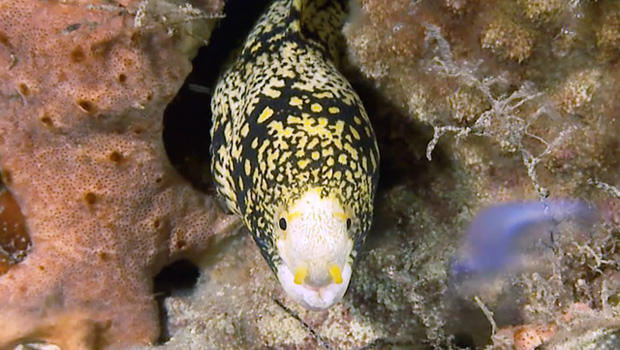Nature up close: Under the sea at Mombasa
By "Sunday Morning" contributing videographer Judy Lehmberg.
The first time I ever snorkeled I apprehensively stuck my face under the water and saw a barracuda racing towards me. Oh my God! I was scared to death, but I was hooked! It was a whole new world under there, and I couldn't wait to see all of it.
My father's company had a contract with the Navy in Puerto Rico when I was 14, so we moved there for the summer. We lived less than a block from Luquillo Beach. Today that beach is covered with people and high-rise hotels, but in the late 1960s it was a sleepy little town with only a sprinkling of tourists. I walked to that beach and swam out to a coral reef every day, where I spent the rest of the day face down in the water. I didn't know the name of too many of the animals, but their images were imprinted on my brain forever. Biology got in my blood and has, thankfully, stayed there ever since.
A number of years later my husband and I went to Kenya and Tanzania. We took the train from Nairobi to Mombasa with no particular goals in mind, but when I saw the Indian Ocean I fell in love. It was the clearest blue-green color I had ever seen. By then I had learned some biology and knew what I was looking at. The species diversity was amazing -- brittle stars which I had studied but never seen; a seemly endless variety of fish; dainty little sea slugs; an octopus; a couple of moray eels; and a cuttlefish, which I had never seen in the wild.
That cuttlefish was amazing! Colors rippled along its skin like pulsating florescent lights. Some of those colors are used as camouflage but others are used to attract mates and mesmerize prey. Their ability to change colors is possible because their skin has several types of cells containing pigments and iridescent crystals. The uppermost layer consists of chromatophores (cells containing a variety of pigments ranging from tan to red). Cuttlefish control their chromatophores with hundreds of small muscles allowing them to expand and contract the cells, resulting in extremely rapid color changes.
Under the chromatophores is a layer of iridophores. Iridophores contain stacks of iridescent plates that polarize light. Cuttlefish are unusual; they can't see colors, but they can see polarized light. That is advantageous because it helps them see their shiny-sided fish prey, but it also allows them to communicate with each other "privately," as most other animals can't see polarized light. One of the ways they use their iridophores is by contracting the chromatophores above, making the iridescence more visible.
Cephalopods include octopi, squid, nautilus and cuttlefish. They are the most intelligent invertebrates (cuttlefish can count to at least five), so much so that aquarium employees name many of them. Some of them are also amazing escape artists.
One of the more misunderstood reef species is the moray eel. Because morays open and close their mouths frequently they look intimidating, but they aren't. They are actually rather shy. They open and close their mouth to facilitate the movement of oxygenated water over their gills. They aren't threatening to humans, but they are predators, and the way they grab their prey is unique. If you were able to watch a moray eel grab its prey in slow motion you would see it has a second set of jaws, not uncommon in fish, but the way they uses them is uncommon.
To understand their jaws it is useful to think about where jaws came from. The earliest fish didn't have jaws, but "newer" fish, like sharks and bony fish, do. If you look at a shark's jaws you will see they are shaped similarly to gill arches, the structures that support gills. Take the first set of gill arches, move them forward and stick some teeth on them, and poof, you have jaws.
All vertebrates that have jaws, including moray eels, got them from that first pair of gill arches. The second set of jaws, the pharyngeal jaws, evolved from the second set of gill arches. The second set of jaws in most fish aid in chewing. In moray eels they are different because they are attached by muscles to the skull and the first set of jaws. When a moray grabs a prey animal it does so with two sets of jaws. The pharyngeal jaws move towards the front of their mouth and clamps down on the prey, then pulling it back to the throat, making swallowing much easier.
The sea creatures along the coast of Mombasa are threatened from increased human population as well as pollution, overfishing, oil and gas exploitation, and climate change. Some coral bleaching has also been observed here. Click here to read more about coral bleaching.
Judy Lehmberg is a former college biology teacher who now shoots nature videos.
For more info:
- Judy Lehmberg (Official site)
- Judy Lehmberg's YouTube Channel
To watch extended "Sunday Morning" Nature videos click here!




